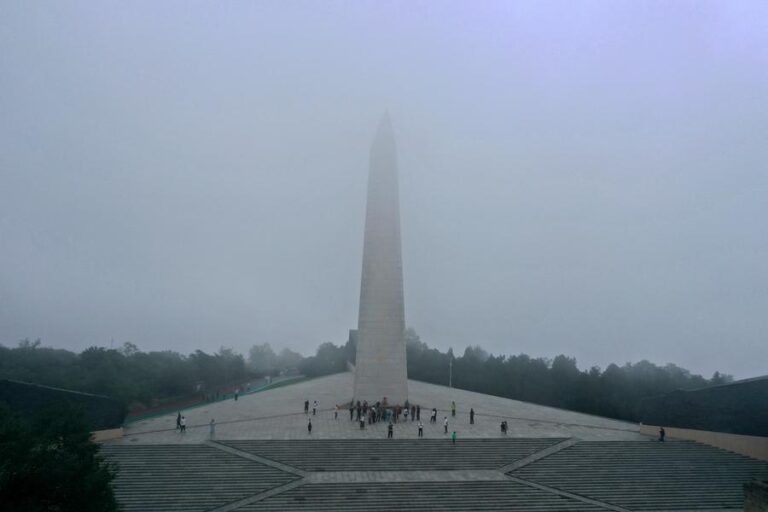TAIYUAN/CHANGSHA, July 27 (Xinhua) — Standing inside the Taihang Memorial Museum of the Eighth Route Army, Chan Cheuk Hong, a journalist from Hong Kong’s TVB, was drawn to a faded, worn-out leather suitcase.
This suitcase once belonged to Zhu De, one of the major founders of the People’s Republic of China.
According to Tian Yuehui, the museum’s deputy curator, after the whole-of-nation resistance against Japanese aggression began in 1937, the Red Army’s main forces were regrouped as the Eighth Route Army, and Zhu De led the Eighth Route Army to the Taihang Mountains to fight the Japanese invaders. The suitcase accompanied him through the battlefields, bearing witness to his command during those turbulent years.
In the early 1940s, Zhu De presented this suitcase to his daughter Zhu Min as a farewell gift when she departed for studies in the Soviet Union. The suitcase had hence become an emotional anchor that sustained Zhu Min through challenging times abroad. In 2005, Zhu Min and her family donated it to the museum.
Moved by the suitcase’s story and other exhibits, Chan reflected: “It’s deeply touching. Many details and artifacts are new to me, reviving memories of the war and offering a fresh history lesson.”
From July 22 to 26, journalists from countries including Britain, France, Russia and Japan, as well as reporters from China’s Hong Kong Special Administrative Region, visited several memorial museums in Shanxi and Hunan to learn about Chinese People’s War of Resistance against Japanese Aggression.
Their first stop was the Taihang Memorial Museum of the Eighth Route Army in Wuxiang County, north China’s Shanxi Province. Wuxiang is the former site of China’s Eighth Route Army Headquarters during the war of resistance against Japanese aggression, home to several battlefields where the Communist Party of China (CPC)-led forces won decisive victories.
The museum also reveals that during the war, out of Wuxiang’s 140,000 residents, over 90,000 joined anti-Japanese activities, 14,600 enlisted in the Eighth Route Army, and more than 20,000 lost their lives.
Salionova Alina, a reporter from Russia’s RT TV, shared her shock: “What struck me most was a chart listing Japanese atrocities — dates, cities, and death tolls. No one could stay calm seeing those numbers. My eyes welled up with tears.”
In central China’s Hunan Province, the journalists learned about the three Battles of Changsha, victories that dealt a heavy blow to Japanese forces and contributed significantly to the formation of the global anti-fascist alliance.
Chen Qinglin, former deputy director of the Hunan Provincial Party History Research Office, noted that China paid a huge sacrifice but effectively contained and decimated Japan’s main forces.
China made a national sacrifice of over 35 million casualties in its fight against the majority of troops of Japanese militarism. During 14 years of fierce anti-fascist fighting, China engaged and tied down over two-thirds of the Japanese Army, inflicting 70 percent of Japan’s wartime military casualties. “We paid the price in blood,” Chen added.
The journalists also met 96-year-old veteran Wen Yunfu, who recalled surviving during the period of Japanese invasion. “We lived in constant fear. I never want to see war or invasion again.”
In Zhijiang Dong Autonomous County, Hunan, the group visited the Flying Tigers Memorial Museum. During World War II, Zhijiang Airport became a key base for the Flying Tigers, the 1st American Volunteer Group formed in 1941 to help China drive out invading Japanese troops. From Aug. 21 to 23, 1945, it was also in Zhijiang that Japanese representatives handed over a map of Japanese troops deployed in China and signed a surrender memorandum.
The old photos, military uniforms, aircraft models, combat maps, and other exhibits vividly capture the lives of these U.S. veteran pilots, sparking great curiosity among the journalists.
Standing in the memorial hall to commemorate Japan’s surrender, curator Wu Jianhong told the reporters that the memorial hall serves as a reminder that “peace is hard-won and that pursuing peaceful development is a common goal for all humanity.”
The trip left a profound impression on the journalists, deepening their understanding of China as the main theater in the East during the World Anti-Fascist War and a major contributor to the war’s victory.
“Overseas reporters should share more of China’s wartime history,” Alina said. “Many believe World War II ended in May when Germany unconditionally surrendered to the Allied forces, but few know it truly concluded on September 2.”
Through this visit, journalists can gain a firsthand understanding of the historical details, physical artifacts, and stories of international cooperation related to China’s War of Resistance against Japanese Aggression, noted Zhai Jiaqi from the 7th Research Department of the Institute of Party History and Literature of the CPC Central Committee.
“This will enable them to have a more personal appreciation of China’s efforts and contributions to global anti-fascist fighting and will also help them understand this period of history better,” she added. ■

